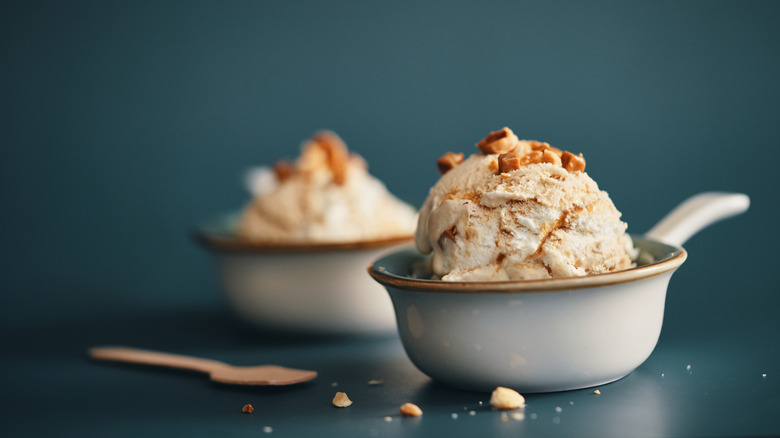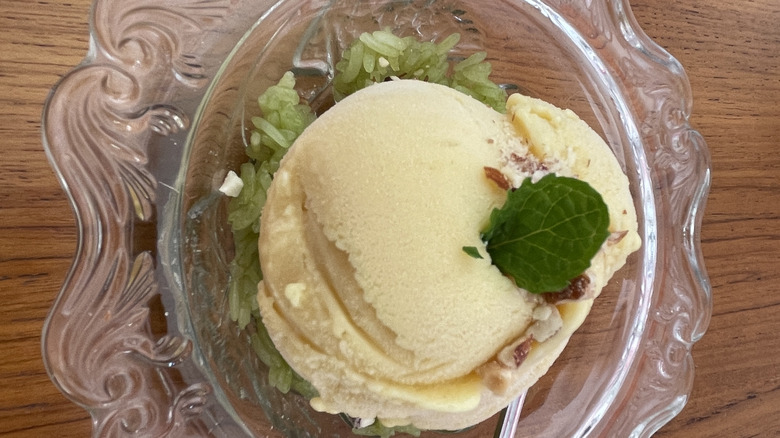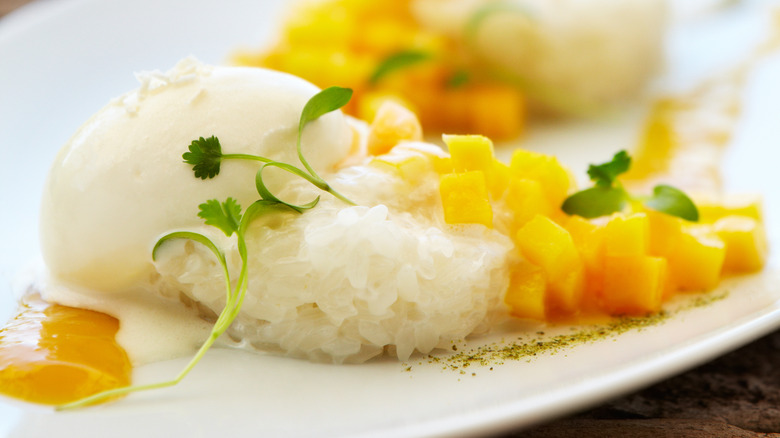Put That Leftover Rice To Good Use And Add It To Homemade Ice Cream
When fluffy, tender white rice piled high in a bowl arrives at the table, most believe that not a single grain will be left at the end of the meal. But when it does, instead of making another batch of fried rice with the leftovers, churn it into a homemade ice cream. The food transformation will be a scoop of satisfying simplicity.
Finding creative, simple ways to reuse leftovers is a big key in avoiding food waste. While plain, cooked white rice might have a multitude of savory applications, taking those grains to the sweeter side, like with a homemade ice cream, can be quite satisfying as well.
Homemade rice ice cream starts basically as a rice pudding. Leftover rice is reheated with cream and sugar to make a base. As the rice grains plump, they absorb the sweetness and the richness from the cream and sugar. (The idea is similar to Philadelphia style ice cream, which uses just milk, sugar, and flavorings.) The velvety dessert is then blended to create a homogeneous texture, and it's frozen for a few hours to resemble ice cream.
Unlike the texture contrast in rice pudding, rice ice cream is better when well-blended and strained to remove any broken grains. The result will be each spoonful offering a creamy, luscious mouthfeel. But, an errant grain or two does not ruin the total enjoyment. Think of it like a sprinkle, just without the colorful whimsy.
Why does leftover rice make for a luscious ice cream base?
Whether packed into a sugar cone or scooped into a bowl, a sumptuous spoonful of ice cream can make even the dreariest days seem brighter. While some sweet caramel swirls or candy pieces can provide added flavor or texture, unwanted ice particles in refrozen ice cream can ruin the experience. However, adding a thickener, like leftover rice, can alleviate that problem.
Some ice cream bases use cornstarch as a stabilizer to help thicken it. The concept is similar to how the ingredient thickens a roux or a sauce where the starch absorbs liquid as it cooks and thickens the consistency. Leftover rice becomes the starch component in the ice cream base; as the rice cooks in the milk and sugar, the liquid becomes more viscous.
Truthfully, rice ice cream is basically a blended, frozen pudding where the richness and creamy mouthfeel is the result of rice's starch stabilizer thickening the base. For that reason, cooked rice is the key since it has had time to swell and release its starches. And big ice crystals cannot form in this mixture, ensuring a creamier texture. The old proverb says that rice is the most versatile grain on the planet and repurposing it into a homemade ice cream is another example of that concept.
The flavors that work well with rice ice cream
Since that plain, white rice is a blank canvas, rice ice cream can go in many various directions. Although a splash of soy for a savory ice cream might create a ruckus around the table, classic flavors can easily work well in the dessert.
Similar to rice pudding, vanilla with a touch of cinnamon is a simple, classic option. Other earthy spices like nutmeg or cardamom can bring a warm, comforting note to the dessert. To make the ice cream taste like an old-fashioned rice pudding, consider folding in some plump raisins for texture.
In some ways, other rice-based desserts can serve as inspiration for the rice ice cream, too. For example, in Thailand, coconut sticky rice with mango is a popular dessert. Consider serving a mango curd swirl or even just some chopped fruit and toasted coconut flakes on top. With a pantry full of flavor options, the grain grows into endless dessert possibilities.


